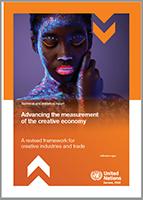
UNCTAD’s Bridgetown Covenant1 (paragraph 54) and General Assembly resolutions 74/198. (on the International Year of Creative Economy for Sustainable Development adopted in 2019) and 78/133. (on promoting creative economy for sustainable development adopted in 2023) provided a mandate to UNCTAD to offer a comprehensive analysis of the creative economy and creative goods and services.
Furthermore, the recent Kashi Culture Pathway (paragraph 10), the outcome document of the G20 Culture Minister’s Meeting, has called for increased collaboration to enhance the conceptual and monitoring framework for cultural and creative sectors and industries, highlighting the roles of relevant international organizations such as the Organisation for Economic Co-operation and Development (OECD), UNCTAD, and UNESCO.
The aim of this technical and statistical report is to address these mandates, assisting countries—particularly, developing and least developed—in mapping their creative industries.
The paper results from a collaborative global consultation involving creative economy experts, United Nations agencies, and experts from national statistical offices.
The paper introduces a statistical framework for measuring the economic impact of creative industries and international trade in creative goods and services. Historically, UNCTAD has lacked a statistical framework for identifying and measuring the economic contribution of creative industries, only focusing on measuring international trade in creative goods and services.
The paper aims to rectify this by incorporating the latest versions of international classifications of industry, product, and trade.
The report has two key objectives:
- Enhance the measurement of the economic contribution of the creative economy by providing a list of creative activities (using the International Standard Industrial Classification of All Economic Activities (ISIC)) and products (using the Central Product Classification (CPC)).
- Improve and update data collection on international trade of creative goods and services by revising UNCTAD’s statistical classification.


